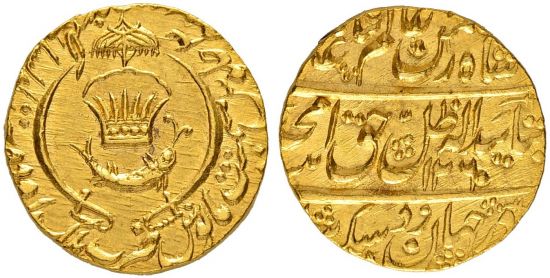Difference between revisions of "Awadh AH 1260(1) ashrafi Fr-1019"
(This page contains material from http://www.coinfactswiki.com/wiki/Awadh_AH_1260%281%29_ashrafi_Fr-1019) |
m (Text replacement - "Zurich:" to "Zürich:") |
||
| (4 intermediate revisions by the same user not shown) | |||
| Line 1: | Line 1: | ||
[[Image:Awadh Sincona 38-1437.jpg|550px|thumb|Sincona sale 38, lot 1437]] | [[Image:Awadh Sincona 38-1437.jpg|550px|thumb|Sincona sale 38, lot 1437]] | ||
| − | This specimen was lot 1437 in Sincona sale 38 ( | + | This specimen was lot 1437 in Sincona sale 38 (Zürich, May 2017), where it sold for 1,400 CHF (about US$1,679 including buyer's fees). The catalog description<sup>[1]</sup> noted, <blockquote>"''Amjad Ali Shah, 1258-1263 AH (1842-1847) Ashrafi 1260 AH, 1. Regierungsjahr (1844). Lucknow Fast FDC. Prüfspur am Rand.'' (Awadh, Amjad Ali Shah, 1258-1263 AH (1842-1847), ashrafi of the year AH 1260, year 1, Lucknow mint. About uncirculated, Test mark on edge.)"</blockquote> This type is listed for AH 1258-1263. Per Wikipedia, "Amjad Ali Shah (b. c. 1801 – d. 13 February 1847) was the fourth King of Oudh from 7 May 1842 to 13 February 1847." His predecessor, Ghazi ud-Din Haidar, promoted himself from nawab to king with British connivance, setting aside the nominal suzerainty of the Mogul emperor. Later, a succession dispute resulted in British intervention and overlordship. Resentment of this and other acts led to the Indian Mutiny of 1857, which was centered at Awadh's capital Lucknow. |
''Recorded mintage:'' unknown. | ''Recorded mintage:'' unknown. | ||
| Line 10: | Line 10: | ||
''[[Bibliography|Source:]]'' | ''[[Bibliography|Source:]]'' | ||
| + | * Friedberg, Arthur L. and Ira S. Friedberg, ''Gold Coins of the World, From Ancient Times to the Present, 9th ed.,'' Clifton, NJ: Coin and Currency Institute, 2017. | ||
* Michael, Thomas, and Tracy L. Schmidt, ''Standard Catalog of World Coins, 1801-1900, 9th ed.'', Iola, WI: Krause Publications, 2019. | * Michael, Thomas, and Tracy L. Schmidt, ''Standard Catalog of World Coins, 1801-1900, 9th ed.'', Iola, WI: Krause Publications, 2019. | ||
| − | + | * <sup>[1]</sup>Jürg Richter, ''Auction 38, Gold Coins and Medals,'' Zürich: Sincona AG, 2017. | |
| − | * <sup>[1]</sup>Jürg Richter, ''Auction 38, Gold Coins and Medals,'' | ||
''Link to:'' | ''Link to:'' | ||
| − | + | * [[Awadh AH 1256(4) ashrafi Fr-1016]] | |
| − | * [[Awadh AH | ||
* [[Awadh AH 1260(2) rupee]] | * [[Awadh AH 1260(2) rupee]] | ||
* [[Awadh AH 1261(3) rupee]] | * [[Awadh AH 1261(3) rupee]] | ||
Latest revision as of 09:36, 20 June 2025
This specimen was lot 1437 in Sincona sale 38 (Zürich, May 2017), where it sold for 1,400 CHF (about US$1,679 including buyer's fees). The catalog description[1] noted,
"Amjad Ali Shah, 1258-1263 AH (1842-1847) Ashrafi 1260 AH, 1. Regierungsjahr (1844). Lucknow Fast FDC. Prüfspur am Rand. (Awadh, Amjad Ali Shah, 1258-1263 AH (1842-1847), ashrafi of the year AH 1260, year 1, Lucknow mint. About uncirculated, Test mark on edge.)"
This type is listed for AH 1258-1263. Per Wikipedia, "Amjad Ali Shah (b. c. 1801 – d. 13 February 1847) was the fourth King of Oudh from 7 May 1842 to 13 February 1847." His predecessor, Ghazi ud-Din Haidar, promoted himself from nawab to king with British connivance, setting aside the nominal suzerainty of the Mogul emperor. Later, a succession dispute resulted in British intervention and overlordship. Resentment of this and other acts led to the Indian Mutiny of 1857, which was centered at Awadh's capital Lucknow.
Recorded mintage: unknown.
Specification: 10.7-11.4 g, gold, this specimen 10.73 g.
Catalog reference: Fr-1019; KM-342.
- Friedberg, Arthur L. and Ira S. Friedberg, Gold Coins of the World, From Ancient Times to the Present, 9th ed., Clifton, NJ: Coin and Currency Institute, 2017.
- Michael, Thomas, and Tracy L. Schmidt, Standard Catalog of World Coins, 1801-1900, 9th ed., Iola, WI: Krause Publications, 2019.
- [1]Jürg Richter, Auction 38, Gold Coins and Medals, Zürich: Sincona AG, 2017.
Link to:
